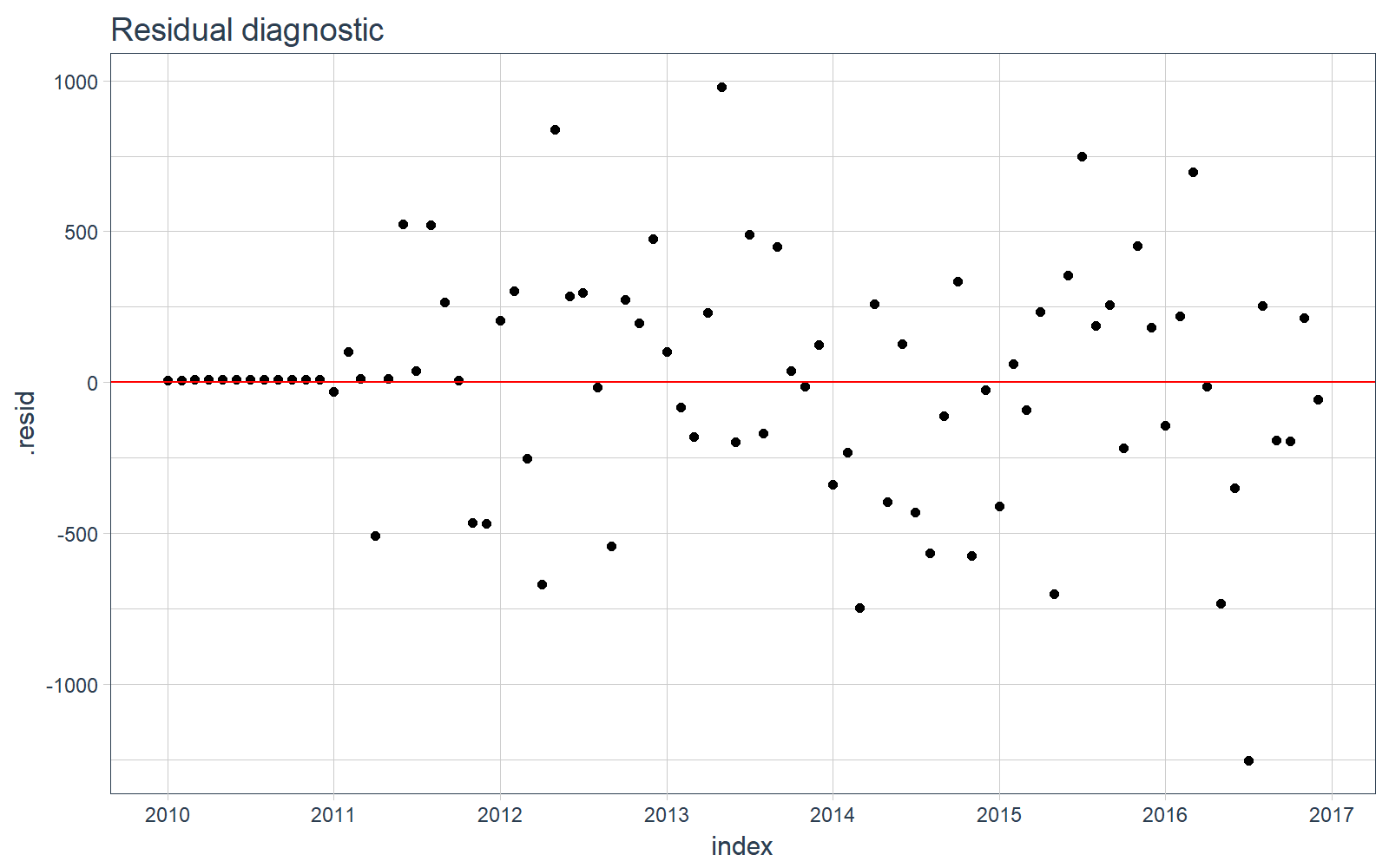面我们就要建立 ARIMA 模型了。
STEP 2A:ARIMA 模型
我们使用 forecast 包里的 auto.arima() 函数为时间序列建模。
# Model using auto.arima
fit_arima <- auto.arima(beer_sales_ts)
fit_arima
## Series: beer_sales_ts
## ARIMA(3,0,0)(1,1,0)[12] with drift
##
## Coefficients:
## ar1 ar2 ar3 sar1 drift
## -0.2498 0.1079 0.6210 -0.2817 32.1157
## s.e. 0.0933 0.0982 0.0925 0.1333 5.8882
##
## sigma^2 estimated as 175282: log likelihood=-535.49
## AIC=1082.97 AICc=1084.27 BIC=1096.63
STEP 2B:简化模型
就像 broom 简化 stats 包的使用一样,我么可以使用 sweep 的函数简化 ARIMA 模型。下面介绍三个函数:
sw_tidy():用于检索模型参数sw_glance():用于检索模型描述和训练集的精确度度量sw_augment():用于获得模型残差
sw_tidy
sw_tidy() 函数以 tibble 对象的形式返回模型参数。
# sw_tidy - Get model coefficients
sw_tidy(fit_arima)
## # A tibble: 5 x 2
## term estimate
## <chr> <dbl>
## 1 ar1 -0.2497937
## 2 ar2 0.1079269
## 3 ar3 0.6210345
## 4 sar1 -0.2816877
## 5 drift 32.1157478
sw_glance
sw_glance() 函数以 tibble 对象的形式返回训练集的精确度度量。可以使用 glimpse 函数美化显示结果。
# sw_glance - Get model description and training set accuracy measures
sw_glance(fit_arima) %>%
glimpse()
## Observations: 1
## Variables: 12
## $ model.desc <chr> "ARIMA(3,0,0)(1,1,0)[12] with drift"
## $ sigma <dbl> 418.6665
## $ logLik <dbl> -535.4873
## $ AIC <dbl> 1082.975
## $ BIC <dbl> 1096.635
## $ ME <dbl> 1.189875
## $ RMSE <dbl> 373.9091
## $ MAE <dbl> 271.7068
## $ MPE <dbl> -0.06716239
## $ MAPE <dbl> 2.526077
## $ MASE <dbl> 0.4989005
## $ ACF1 <dbl> 0.02215405
sw_augument
sw_augument() 函数返回的 tibble 表中包含 .actual、.fitted 和 .resid 列,有助于在训练集上评估模型表现。注意,设置 timetk_idx = TRUE 返回初始的日期索引。
# sw_augment - get model residuals
sw_augment(fit_arima, timetk_idx = TRUE)
## # A tibble: 84 x 4
## index .actual .fitted .resid
## <date> <dbl> <dbl> <dbl>
## 1 2010-01-01 6558 6551.474 6.525878
## 2 2010-02-01 7481 7473.583 7.416765
## 3 2010-03-01 9475 9465.621 9.378648
## 4 2010-04-01 9424 9414.704 9.295526
## 5 2010-05-01 9351 9341.810 9.190414
## 6 2010-06-01 10552 10541.641 10.359293
## 7 2010-07-01 9077 9068.148 8.852178
## 8 2010-08-01 9273 9263.984 9.016063
## 9 2010-09-01 9420 9410.869 9.130943
## 10 2010-10-01 9413 9403.908 9.091831
## # ... with 74 more rows
我们可以可视化训练数据上的残差,看一下数据中有没有遗漏的模式没有被发现。
# Plotting residuals
sw_augment(fit_arima, timetk_idx = TRUE) %>%
ggplot(aes(x = index, y = .resid)) +
geom_point() +
geom_hline(yintercept = 0, color = "red") +
labs(title = "Residual diagnostic") +
scale_x_date(date_breaks = "1 year", date_labels = "%Y") +
theme_tq()

STEP 3:预测
使用 forecast() 函数做预测。
# Forecast next 12 months
fcast_arima <- forecast(fit_arima, h = 12)
一个问题是,预测结果并不“tidy”。我们需要数据框形式的预测结果,以便应用 tidyverse 的功能,然而预测结果是 forecast 类型的,一种基于 ts 的对象。
class(fcast_arima)
## [1] "forecast"
STEP 4:用 sweep 简化预测
我们使用 sw_sweep() 简化预测结果,一个额外的好处是,如果 forecast 对象有 timetk 索引,我们可以用它返回一个日期时间索引,不同于 ts 对象的规则索引。
首先要确认 forecast 对象有 timetk 索引,这需要在使用 sw_sweep() 时设置 timetk_idx 参数。
# Check if object has timetk index
has_timetk_idx(fcast_arima)
## [1] TRUE
现在,使用 sw_sweep() 来简化预测结果,它会在内部根据 time_tk 构造一条未来时间序列索引(这一步总是会被执行,因为我们在第 1 步中用 tk_ts() 构造了 ts 对象)注意:这意味着我们最终可以在 forecast 包中使用日期(不同于 ts 对象中的规则索引)!。
# sw_sweep - tidies forecast output
fcast_tbl <- sw_sweep(fcast_arima, timetk_idx = TRUE)
fcast_tbl
## # A tibble: 96 x 7
## index key price lo.80